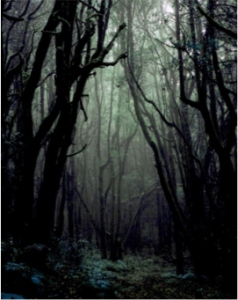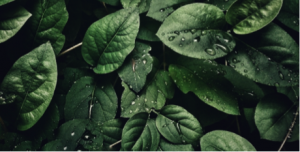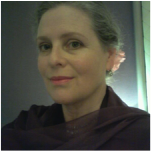Part I, Holy Week 2021, Maundy Thursday.
Absence mills around the body like a guard dog pacing the fence line. Rigidly keeping off the night creatures, jealously defending its property. I am within a picketed sphere of isolation. Longing, despair, confusion at the memory of the banquet torn to pieces, guests fleeing, music stopped. Not long ago the home was filled with shining lamps and food for all – now desolate in an endless stand of trees, mist creeping inward from the wetlands, penetrating the outer walls however much the dog may growl and bark.
We have little choice but to brave absence this Holy Week.
How the year has taken its toll. Perhaps at first we were secretly exhilarated to be holed up and quiet. A contemplative’s dream: the world finally sees the necessity of stillness and seclusion. We know that not everyone perceives our circumstances as vibrant potential, but nevertheless, solitude now has cachet, even nobility and valour. How curious and refreshing to be in a world that is not entirely at odds with us.
Yet the novelty has passed, as months melt one into another. Family, friends, and all of society suffer. The weight of days bears down. Anxiety rises over our vulnerabilities, collective and personal. This has become a year of letting go and hanging on in equal measure. Like an expanded Holy Week with no Easter yet in sight. We are like Mary Magdalene and the disciples, who don’t know where this is headed. Are we sensing into a mammoth shift that requires our stillness and attention—and also our loss—or are we in freefall? Is this the swamp that putrefies or purifies the water of life?
An unexpected space has shambled open at my centre, not so clearly the contemplative openness of invitation and peace, but something more like a ravening maw. However much I keep my practice of meditation and prayer, absence has begun to take me.
I am surprised. Have I not prepared for this necessary, desired dismantling? Illness and death among family and friends, research at a standstill, writing projects crumbling like ancient papyrus exposed to sun and air, unspoken tensions surreptitiously rising in households, income lost, bills unpaid, loneliness, hunger. If we who adore solitude have thus diminished, how can those who are in real need of lively, face-to-face interaction prosper in the enforced enclosure?
I hear the forest beyond the cabin walls, beyond the dog-stalked boundary. At dusk the curling mist inches along the forest floor from wetland bogs, breaching my perimeter. As I meditate, my hands sense the approach and gesture inquiry, fingers barely open like in-folded flames of delicate salmonberry buds, or in darker moments, like the spotted turquoise pincers of crayfish grasping in graveled eddies, so eager for food to come their way.
The mist lingers and moves imperceptibly over the rippling stream. Shoots of cloudberry, sundew, and Labrador tea peek through sphagnum moss, a hint of possibility. The mist edges through the understorey at the base of greater life: salal, Douglas fir, and yellow cedar. It creeps towards me as I sit immobile, not knowing the way forward or back. The bog mist creeps over the lotus of my meditating body, toward forlorn emptiness. A gaping gash that cannot be sealed, memorialized, or lightly forgotten, but instead yawns to be filled, like Good Friday’s empty tabernacle.
Mary Magdalene didn’t know. Nor do we. This story has no dramatic irony, where the liturgical actors are comforted in their knowledge of how the rite will end. We don’t know if we will once again thrive, if our livelihoods will stabilize, if social and political institutions will ossify into harder battalions or transform for the good of all. We don’t know whether we are adequately equipped to respond and adapt to what may be a greater reckoning.
 But that forbidding mist condenses into droplets that slake the thirst, leaching down into earth. The water that seems stagnant and putrid in the muck of duckweed and slime filters still and quiet, ever more deeply, through peat and mud, silt and gravel. In its own time, marsh water seeps into the torn body and unseeable depths to become a flow of pure groundwater seeking the right place to emerge. What appears putrid may be the channel of purification.
But that forbidding mist condenses into droplets that slake the thirst, leaching down into earth. The water that seems stagnant and putrid in the muck of duckweed and slime filters still and quiet, ever more deeply, through peat and mud, silt and gravel. In its own time, marsh water seeps into the torn body and unseeable depths to become a flow of pure groundwater seeking the right place to emerge. What appears putrid may be the channel of purification.
The forest sounds begin to draw us out beyond the fence: rushing wind, chortling raven, creaking branches. The aching cave of absence turns into the cave of the heart where we await the Beloved. We cannot alone heal the absence but, like Mary Magdalene, we can choose loyalty and love, and thus keep our vigil, however unsure we may be.
There is a tangle of underbrush in me: parsing the harsh reality of mourning with the responsibility of consenting to the Divine on behalf of all. I cannot pretend to understand the depth and breadth of the underground streams of the pain body that can be collectively nudged towards transformation. I cannot pretend to fully grasp the enigmatic facets of intentional suffering – an intercession of purity, spaciousness, and generosity that seeks and welcomes the Divine regardless of our pain. Humility is the best correction for my temptation to fake that knowledge (that I am beyond suffering or that I understand its purpose). Despite me, despite my lack of clarity and fortitude, the forest mist condenses, seeps, and flows while I attempt spacious, generous, and pure attentiveness in the face of world-rending absence.
A steadier time may be at hand. Steadier breath, when hands can again be put to work and eyes can again be opened and mouths can again form words. Underneath, the waiting continues. The vigil at the tomb. The longing.
I see now that the tomb is myself. My cracked centre is the fissured rock face awaiting Christ’s body. I hold the death; I throw open the gate to the forest wind and whirling mist.
Who would agree to cradle death except for the sake of love? Our only choice now is to wait at the tomb.
 Maundy Thursday 2021
Maundy Thursday 2021
Vancouver, BC
 Paula serves on the board of our sister ship The Contemplative Society where you will also find Paula’s writing (thank you Eilen!). Her contributions to Northeast Wisdom / Wisdom Waypoints include No Question: A Pilgrimage to India with Rev. Matthew Wright and Br. Aidan Owen, OHC on the home page blog and Living Waters and COVID-19 on the Forum. Learn more about Paula Pryce on her Faces of Wisdom Profile here.
Paula serves on the board of our sister ship The Contemplative Society where you will also find Paula’s writing (thank you Eilen!). Her contributions to Northeast Wisdom / Wisdom Waypoints include No Question: A Pilgrimage to India with Rev. Matthew Wright and Br. Aidan Owen, OHC on the home page blog and Living Waters and COVID-19 on the Forum. Learn more about Paula Pryce on her Faces of Wisdom Profile here.
Paula is the author of The Monk’s Cell, for which, in part, she followed Cynthia Bourgeault and members of our Wisdom community. It is available from Oxford University Press for a 30% discount with promotional code AAFLYG6 entered and applied on your shopping cart. The Press says about the book:
The call to contemplative Christianity is not an easy one. Those who answer it set themselves to the arduous task of self-reformation through rigorous study and practice… Those who are dedicated can spend hours every day in meditation, prayer, liturgy, and study. Why do they come? Indeed, how do they find their way to the door at all?
Based on nearly four years of research among semi-cloistered Christian monastics and a dispersed network of non-monastic Christian contemplatives across the United States and around the globe… Organized by the metaphor of a seeker journeying towards the inner chambers of a monastic chapel, The Monk’s Cell uses innovative “intersubjective fieldwork” methods… to show how practices like solitude, chant, contemplation, attention, and a paradoxical capacity to combine ritual with intentional “unknowing” develop and hone a powerful sense of communion with the world.
Images from the top: Leaves with Droplets, courtesy of artist sohail na, Pexels; Northern Forest, origin unknown; Old Growth Forest, courtesy of PxHere.


